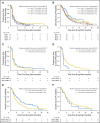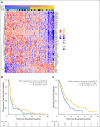The BATTLE-2 Study: A Biomarker-Integrated Targeted Therapy Study in Previously Treated Patients With Advanced Non-Small-Cell Lung Cancer
- PMID: 27480147
- PMCID: PMC5065110
- DOI: 10.1200/JCO.2015.66.0084
The BATTLE-2 Study: A Biomarker-Integrated Targeted Therapy Study in Previously Treated Patients With Advanced Non-Small-Cell Lung Cancer
Abstract
Purpose: By applying the principles of real-time biopsy, biomarker-based, adaptively randomized studies in non-small-cell lung cancer (NSCLC) established by the Biomarker-Integrated Approaches of Targeted Therapy for Lung Cancer Elimination (BATTLE) trial, we conducted BATTLE-2 (BATTLE-2 Program: A Biomarker-Integrated Targeted Therapy Study in Previously Treated Patients With Advanced Non-Small Cell Lung Cancer), an umbrella study to evaluate the effects of targeted therapies focusing on KRAS-mutated cancers.
Patients and methods: Patients with advanced NSCLC (excluding sensitizing EGFR mutations and ALK gene fusions) refractory to more than one prior therapy were randomly assigned, stratified by KRAS status, to four arms: (1) erlotinib, (2) erlotinib plus MK-2206, (3) MK-2206 plus AZD6244, or (4) sorafenib. Tumor gene expression profiling-targeted next-generation sequencing was performed to evaluate predictive and prognostic biomarkers.
Results: Two hundred patients, 27% with KRAS-mutated (KRAS mut+) tumors, were adaptively randomly assigned to erlotinib (n = 22), erlotinib plus MK-2206 (n = 42), MK-2206 plus AZD6244 (n = 75), or sorafenib (n = 61). In all, 186 patients were evaluable, and the primary end point of an 8-week disease control rate (DCR) was 48% (arm 1, 32%; arm 2, 50%; arm 3, 53%; and arm 4, 46%). For KRAS mut+ patients, DCR was 20%, 25%, 62%, and 44% whereas for KRAS wild-type patients, DCR was 36%, 57%, 49%, and 47% for arms 1, 2, 3, and 4, respectively. Median progression-free survival was 2.0 months, not different by KRAS status, 1.8 months for arm 1, and 2.5 months for arms 2 versus arms 3 and 4 in KRAS mut+ patients (P = .04). Median overall survival was 6.5 months, 9.0 and 5.1 months for arms 1 and 2 versus arms 3 and 4 in KRAS wild-type patients (P = .03). Median overall survival was 7.5 months in mesenchymal versus 5 months in epithelial tumors (P = .02).
Conclusion: Despite improved progression-free survival on therapy that did not contain erlotinib for KRAS mut+ patients and improved prognosis for mesenchymal tumors, better biomarker-driven treatment strategies are still needed.
Conflict of interest statement
Authors’ disclosures of potential conflicts of interest are found in the article online at
Figures




Comment in
-
Precision medicine in lung cancer: the battle continues.J Thorac Dis. 2016 Nov;8(11):2991-2993. doi: 10.21037/jtd.2016.11.46. J Thorac Dis. 2016. PMID: 28066565 Free PMC article. No abstract available.
-
Lessons learned from BATTLE-2 in the war on cancer: the use of Bayesian method in clinical trial design.Ann Transl Med. 2016 Dec;4(23):466. doi: 10.21037/atm.2016.11.48. Ann Transl Med. 2016. PMID: 28090522 Free PMC article. No abstract available.
-
Going into BATTLE: umbrella and basket clinical trials to accelerate the study of biomarker-based therapies.Ann Transl Med. 2016 Dec;4(24):529. doi: 10.21037/atm.2016.12.57. Ann Transl Med. 2016. PMID: 28149890 Free PMC article. No abstract available.
Similar articles
-
Mutations in the epidermal growth factor receptor and in KRAS are predictive and prognostic indicators in patients with non-small-cell lung cancer treated with chemotherapy alone and in combination with erlotinib.J Clin Oncol. 2005 Sep 1;23(25):5900-9. doi: 10.1200/JCO.2005.02.857. Epub 2005 Jul 25. J Clin Oncol. 2005. PMID: 16043828 Clinical Trial.
-
Prospective molecular marker analyses of EGFR and KRAS from a randomized, placebo-controlled study of erlotinib maintenance therapy in advanced non-small-cell lung cancer.J Clin Oncol. 2011 Nov 1;29(31):4113-20. doi: 10.1200/JCO.2010.31.8162. Epub 2011 Oct 3. J Clin Oncol. 2011. PMID: 21969500 Clinical Trial.
-
Randomized Phase II Trial of Seribantumab in Combination with Erlotinib in Patients with EGFR Wild-Type Non-Small Cell Lung Cancer.Oncologist. 2019 Aug;24(8):1095-1102. doi: 10.1634/theoncologist.2018-0695. Epub 2019 Apr 11. Oncologist. 2019. PMID: 30975923 Free PMC article. Clinical Trial.
-
Selumetinib with and without erlotinib in KRAS mutant and KRAS wild-type advanced nonsmall-cell lung cancer.Ann Oncol. 2016 Apr;27(4):693-9. doi: 10.1093/annonc/mdw008. Epub 2016 Jan 22. Ann Oncol. 2016. PMID: 26802155 Free PMC article.
-
Selumetinib in advanced non small cell lung cancer (NSCLC) harbouring KRAS mutation: endless clinical challenge to KRAS-mutant NSCLC.Rev Recent Clin Trials. 2013 Jun;8(2):93-100. doi: 10.2174/15748871113089990047. Rev Recent Clin Trials. 2013. PMID: 24063423 Review.
Cited by
-
Adaptive Clinical Trials: Advantages and Disadvantages of Various Adaptive Design Elements.J Natl Cancer Inst. 2017 Jun 1;109(6):djx013. doi: 10.1093/jnci/djx013. J Natl Cancer Inst. 2017. PMID: 28376148 Free PMC article.
-
Novel clinical trial designs emerging from the molecular reclassification of cancer.CA Cancer J Clin. 2025 May-Jun;75(3):243-267. doi: 10.3322/caac.21880. Epub 2025 Jan 22. CA Cancer J Clin. 2025. PMID: 39841128 Free PMC article. Review.
-
Literature review of advances and challenges in KRAS G12C mutant non-small cell lung cancer.Transl Lung Cancer Res. 2025 Jul 31;14(7):2799-2820. doi: 10.21037/tlcr-2025-164. Epub 2025 Jul 15. Transl Lung Cancer Res. 2025. PMID: 40799453 Free PMC article. Review.
-
The Renaissance of KRAS Targeting in Advanced Non-Small-Cell Lung Cancer: New Opportunities Following Old Failures.Front Oncol. 2021 Dec 23;11:792385. doi: 10.3389/fonc.2021.792385. eCollection 2021. Front Oncol. 2021. PMID: 35004317 Free PMC article. Review.
-
Mutations in the SWI/SNF complex induce a targetable dependence on oxidative phosphorylation in lung cancer.Nat Med. 2018 Jul;24(7):1047-1057. doi: 10.1038/s41591-018-0019-5. Epub 2018 Jun 11. Nat Med. 2018. PMID: 29892061 Free PMC article.
References
-
- Ferlay J, Shin HR, Bray F, et al. Estimates of worldwide burden of cancer in 2008: GLOBOCAN 2008. Int J Cancer. 2010;127:2893–2917. - PubMed
-
- Siegel RL, Miller KD, Jemal A. Cancer statistics, 2015. CA Cancer J Clin. 2015;65:5–29. - PubMed
-
- Le Chevalier T, Scagliotti G, Natale R, et al. Efficacy of gemcitabine plus platinum chemotherapy compared with other platinum containing regimens in advanced non-small-cell lung cancer: A meta-analysis of survival outcomes. Lung Cancer. 2005;47:69–80. - PubMed
-
- Toyooka S, Mitsudomi T, Soh J, et al. Molecular oncology of lung cancer. Gen Thorac Cardiovasc Surg. 2011;59:527–537. - PubMed
Grants and funding
LinkOut - more resources
Full Text Sources
Other Literature Sources
Research Materials
Miscellaneous

